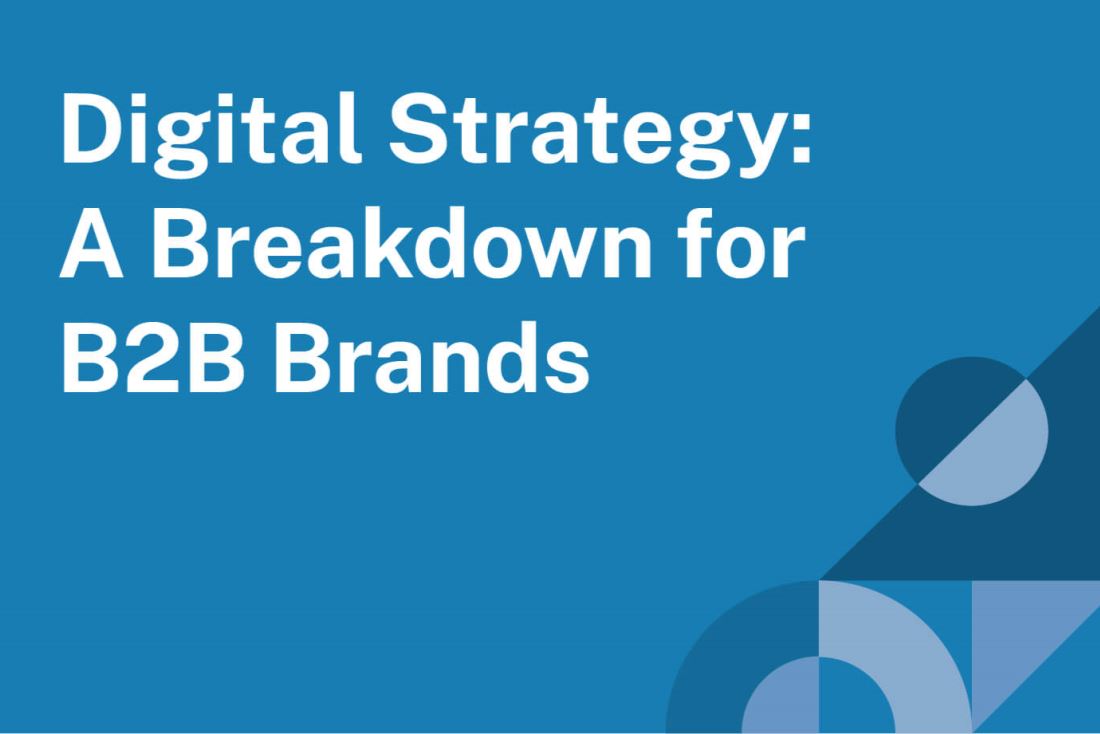Article
Breaking Down Digital Marketing Tactics for B2B Brands

What is a B2B digital marketing strategy?
A B2B digital marketing strategy is a combination of several types of marketing, where the sum is greater than its parts. Now, you’re educating, convincing, and selling to audiences through a multi-pronged approach. Things like like video, social, a blog post and your website become cogs in your marketing plan.
This post is a digital marketing strategy example. We want to show how tactics can align to form a complete strategy.
Every B2B digital strategy plan is different. Or at least, they should be, depending on business goals and your audience. But the results should be consistent. Every person receives the right message, at the right time. This process moves target audiences through a 3-step process:
1) Being aware of your business
2) Considering your product and weighing the advantages
3) Deciding to buy or subscribe to your product or service.
If you already know all this, and only want to see results, check out our digital strategy case study.
Elements of a Digital Marketing Strategy
No two digital marketing strategies are the same. Makes sense, no two B2B companies are the same.
But you will see the same channels. Here are the 10 channels we often use when creating digital strategies for B2B companies.
We’ll break down the benefits of each type of campaign in the next section.
- Research & strategy development
- Website & e-commerce branding
- Social media marketing
- Search engine optimization (SEO)
- Search engine marketing (SEM)
- Email marketing
- Video marketing
- Digital marketing
- Inbound marketing & marketing automation
- Analytics & optimization
Research and Digital Strategy Development
In strategy development, we determine key marketing channels to reach your audience. This is where we design your custom digital strategy. But to do that, plenty of research must come first:
- Competitive analysis
- Keyword research
- B2B brand strategy (unique value proposition, differentiators)
- What content marketing works for your audience
After sifting through research, we learn the best channels to reach your target audience. And by best, we mean most effective. We’re looking for the digital strategies that move the needle.
Different forms of digital content will be more or less effective, depending on the audience. That’s the question this strategy phase answers. “What’s the fastest, most effective way to achieve our goal.”
This is where the digital strategy plan takes shape. It answers the who, what, when, where, how and why of your B2B digital marketing plan, such as:
- Who you’re talking to
- What you’re saying
- When you should publish messages
- Where are you posting these messages
- How often you’re communicating
- Why audiences should care
Website and E-Commerce Branding
Now you have your plan, it’s time to put it in motion. We like to position the website as the centerpiece of your B2B digital strategy.
This means funneling audiences to your website through all other content marketing efforts.
Why? Because that’s where your best content should be (like blog posts or white papers). It’s where your unique value propositions live. And it will be one of your best lead generation tools, with landing pages and contact forms.
The goal is to turn a website from an informational tool into a lead generating machine.
Social Media Marketing Strategy
What if you already have great content on your website, but no one’s finding it. Or, what if your audience needs a better way to ask questions or discuss problems.
Social media marketing is another great tool in your marketing tool belt. You can use it to raise awareness of your services, or engage current audiences until they’re ready to buy from you. You can even use it to spur existing customers to buy again.
Whether you’re pushing content or pulling in audiences, a social strategy will define:
- Social media goals
- Which social media platforms to use
- How often you’re posting
- What content you’re sharing
Search Engine Optimization (SEO) Strategy
Search Engine Optimization changes a lot (thanks, Google algorithms). And the rate of Google algorithms updates are ramping up.
The one constant is the fact that SEO is crucial in organic traffic. It determines whether your content shows up in search engines . . . or not.
This is where your research and planning stages pay off. At BrandExtract, we blend keyword research, Google trends, your website analytics and much more to identify which search terms you can rank for. Plus, we help the right people find your best content.
After all, qualified traffic leads to more conversions. And conversions are the goal of most B2B digital marketing strategies.
Search Engine Marketing (SEM) Strategy
If SEO is for organic growth, Search Engine Marketing is for paid growth. Assuming you’ve ever used Google, you’ll recognize these as the “paid” search results.
SEM campaigns allow you to pay for top keyword placements in search engine results pages. SEM is effective, as it works with every stage of the sales funnel.
This works for smaller organizations without much visibility in search engines. It also is useful for ranking higher than competitors in search engine results pages.
To see an example of digital marketing strategy in action, check out this case study.
Email Marketing Strategy
Since we’re on the topic of leads, serious question: does your company use their leads well?
Most companies can earn a few leads, but only a low percentage of these turn into sales. So what’s the problem? These companies are forgetting lead nurturing.
Email marketing is a great tactic for lead nurturing. You can pepper audiences with the right message. You can save special email promotions for engaged people. The kind of audiences who want new products or special discounts. This is what transitions audiences through the buyers journey.
Most leads aren’t ready to buy from you just yet. They need more info, reminders and even special offers to convert them.
With your B2B marketing strategy in-hand, you’ll understand target audience needs and their place in the buyers journey. Now you can offer the right content at the right time, turning leads into sales.
Video Marketing Strategy
Video is huge, and only expected to get bigger by 2020. We see this change happening now: YouTube is the 2nd largest search engine, right behind Google. Fact is, most people prefer video over long-form content.
Luckily, digital marketing supports this by upping the value of every video.
This goes beyond uploading your video to YouTube or Vimeo. Video marketing boosts website product pages, helping to close a sale. Or, edit your video into bite-sized chunks, then share it on social media. It a perfect attention grabber at trade show booths. You can even reuse them for presentation materials or product explanations.
And best of all, video marketing aligns with every stage of the buyers journey.
B2B Online Marketing
Defining online marketing can be a little nebulous. It’s an umbrella term that covers many forms of advertising through digital channels. (Or, every form of marketing discussed above).
This type of online marketing puts messages right in front of an audience, whether these messages are relevant or expected. For example, online banners on popular websites.
Note that we said “whether these messages are relevant or expected”. This approach relies on “pushing” messages onto audiences. But the next section shows how to“pull” or attract audiences with useful content and a call-to-action.
Inbound Marketing & Marketing Automation
Here’s the big marketing buzzword of the last few years: inbound marketing.
Inbound marketing represents a fundamental shift in the way we think about digital marketing strategies. We wrote a whole other guide on inbound marketing. In this blog post, we’ll leave it at this:
Traditional marketing, also called outbound marketing, involves creating marketing materials, then blasting them out to audiences.
Inbound marketing also involves creating marketing materials. But then, you make pathways and lead flows for audiences to discover your content at their own pace.
By using marketing automation, people find content on their own terms, in their own time. This leads to more sales and greater lead generation, as people can find the product info they need. They’re willing to exchange contact info for discounts or other content offers.
Marketing automation also saves time, since these materials are sent based on behavior triggers. No more manual entry for routine marketing tasks. See? Inbound marketing is totally different than outbound marketing.
At BrandExtract, we use HubSpot, an inbound marketing platform. Check out our work with HubSpot in our digital marketing case study.
Analytics & Optimization
Digital marketing strategies are never “done”. We want to analyze every new strategy and tactic to prove it works. And that’s where analytics and optimization comes in.
To see what’s working, and what needs improvement, you need to gather analytics for each form of marketing. We’re talking –blogs, emails, social media – every type of content marketing you use.
These marketing analytics also contrast your performance with competitors, benchmarks and your KPIs. This data is quantitative, but a great digital strategist can interpret the data to reveal the “why” behind audience behavior.
The insights are invaluable. It shows what content is most engaging to users, which products have the highest conversion rate, the types of content marketing that earns the most leads and much, much more.
At BrandExtract, we use Google Analytics and a host of other tools to track website performance.
Google Analytics is a great entry tool for B2B companies. It’s free, easy to use and can help you better understand why your website works for your target audience. And what type of content they like to see.
B2B Digital Marketing Example
I hope this digital marketing example clarifies our process. It’s important to remember: a B2B digital marketing strategy can incorporate all 10 channels or a select few. What’s most important is aligning each digital marketing tactic with your target audience goals and your sales funnel.
So, what are the end benefits of content marketing for B2B companies?
Benefits of B2B Digital Marketing Tactics
- Boost traffic to your website
- Generate leads
- Improve website performance, month over month
- Streamline your sales funnels
- Identify which digital marketing campaigns move the needle
- Increase sales with a repeatable process
Expand Your B2B Marketing Efforts with the Power of Inbound Marketing
Maximize your digital marketing by downloading our free "Inbound Marketing Guide." Explore comprehensive step-by-step tips on how to build your own inbound marketing program.

